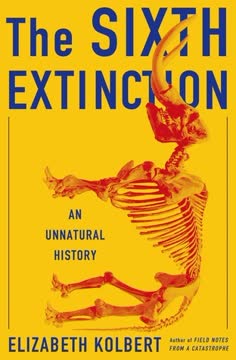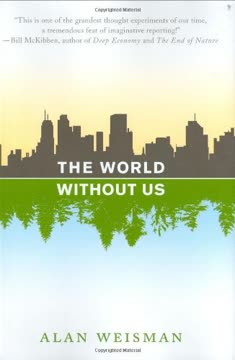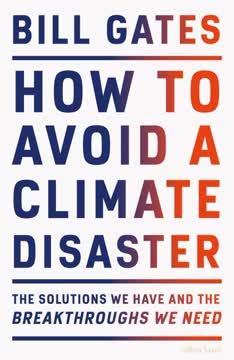Key Takeaways
1. Reversing Global Warming: The Only Goal.
In atmospheric terms drawdown is that point in time at which greenhouse gases peak and begin to decline on a year-to-year basis.
Naming the goal. For too long, the conversation around climate change has focused on slowing, capping, or arresting emissions. While necessary, these actions are insufficient. The only goal that makes sense for humanity is to reverse global warming, reaching "drawdown" where atmospheric greenhouse gas concentrations begin to decline.
Beyond slowing down. If you are traveling down the wrong road, you are still on the wrong road if you slow down. The book argues that by naming the goal of reversal, we inspire the creativity, compassion, and genius needed to achieve it, shifting from a mindset of inevitability to one of invitation.
A human agenda. This is not a liberal or conservative issue; it is a human one. Global warming is happening for us, inspiring us to change and reimagine everything we make and do, taking 100% responsibility and stopping the blame game.
2. The Power of Existing Solutions.
In conducting our research, we found a plan, a blueprint that already exists in the world in the form of humanity’s collective wisdom, made manifest in applied, hands-on practices and technologies that are commonly available, economically viable, and scientifically valid.
A comprehensive plan exists. The book isn't proposing new, untested ideas. Instead, it identifies and models 100 solutions that are already in place around the world, implemented by individuals, communities, cities, companies, and governments.
Proven and scalable. These solutions are not theoretical; they are being practiced today and have the potential to scale significantly. The research rigorously measures their potential impact on reducing or sequestering greenhouse gases over the next three decades.
Beyond technology. The solutions encompass a wide range of approaches, including:
- Technological innovations (e.g., solar, LEDs)
- Ecological practices (e.g., regenerative agriculture, forest protection)
- Social strategies (e.g., educating girls, family planning)
3. Food & Land Use: Turning Sources into Sinks.
Instead of releasing carbon dioxide and other greenhouse gases into the atmosphere, food production can capture carbon as a means to increase fertility, soil health, water availability, yields, and ultimately nutrition and food security.
Agriculture's significant impact. The food system, from farming to waste, is a major contributor to global warming, ranking as a top source of emissions. Conventional practices often deplete soil carbon and rely on energy-intensive inputs.
Regenerative practices. A suite of solutions focuses on transforming agriculture from a carbon source to a carbon sink. These include:
- Plant-rich diets: Reducing meat consumption, especially beef, significantly lowers emissions.
- Regenerative agriculture: Practices like no-till, cover cropping, and managed grazing build soil carbon and reduce chemical use.
- Agroforestry: Integrating trees into farms (silvopasture, tree intercropping) sequesters carbon and diversifies income.
- Improved rice cultivation: Water management techniques reduce methane emissions from paddies.
Restoring degraded lands. Abandoned farmlands and degraded forests offer immense potential for carbon sequestration through restoration, turning forgotten areas into productive ecosystems that enhance biodiversity and water cycles.
4. Empowering Women & Girls: A Climate Imperative.
Securing the fundamental right to voluntary, high-quality family planning services around the world would have powerful positive impacts on the health, welfare, and life expectancy of both women and their children.
Disproportionate vulnerability, pivotal role. Climate change impacts women and girls more severely due to existing inequalities, yet they are crucial agents of change. Solutions focusing on their well-being have profound climate benefits.
Education's ripple effect. Educating girls is one of the most powerful climate solutions.
- Educated women have fewer, healthier children and greater control over their reproductive health.
- Education increases resilience to natural disasters and empowers women as stewards of natural resources.
- It breaks cycles of poverty and contributes to economic growth.
Family planning as a right. Providing universal access to voluntary family planning services is a matter of human dignity and autonomy. Meeting women's expressed needs for contraception has significant implications for stabilizing population growth, especially when combined with education.
5. Buildings & Cities: Designing for Efficiency & Livability.
Rather than being a source or cause of degeneration, cities are becoming regenerative to the environment and human well-being.
Urban transformation. Cities, often seen as environmental burdens, can become hubs of sustainability and regeneration through smart design and technology. Buildings and urban infrastructure offer significant opportunities for emissions reduction.
Efficiency is key. Solutions focus on drastically reducing energy use in buildings:
- Net zero buildings: Designing structures that produce as much energy as they consume annually.
- Insulation & retrofitting: Improving the thermal envelope of new and existing buildings.
- Smart technologies: Using smart thermostats, smart glass, and building automation systems to optimize energy use.
- District heating/cooling: Centralized systems leverage waste heat and improve efficiency in dense areas.
Walkable and bikeable. Urban design that prioritizes people over cars reduces transport emissions and enhances livability.
- Walkable cities: Creating dense, mixed-use neighborhoods where daily needs are accessible on foot.
- Bike infrastructure: Building safe and connected bike lanes encourages cycling for short trips.
6. Transport: Moving Beyond Fossil Fuels.
The era of fossil fuels is over, and the only question now is when the new era will be fully upon us.
Shifting mobility. The transport sector is a major source of emissions, but solutions are rapidly emerging to move beyond fossil fuels and increase efficiency.
Electrification and efficiency.
- Electric vehicles: EVs are significantly more efficient than gasoline cars, and their emissions drop further when powered by renewable energy.
- Hybrid cars: Provide a bridge technology, improving fuel economy until full electrification is widespread.
- Efficient trucks, ships, and airplanes: Improving the aerodynamics, engines, and operational practices of freight and air travel reduces fuel consumption.
Alternative modes. Encouraging shifts to less carbon-intensive ways of moving people and goods.
- Mass transit: Moving more people in smaller footprints reduces per-passenger emissions.
- High-speed rail: Offers a low-carbon alternative to flying or driving for medium distances.
- Ridesharing & electric bikes: Increase efficiency and reduce reliance on single-occupancy vehicles.
7. Materials & Waste: Closing the Loop.
In nature, cycles abound. Water and nutrients move in closed loops, and there is no waste. Instead, discards become resources.
Waste equals food. The industrial model of "take, make, waste" is unsustainable. Adopting circular economy principles, where waste becomes feedstock for new products, is essential for reducing emissions from material production and disposal.
Recycling's impact. Recycling significantly reduces the energy and emissions associated with creating new materials.
- Household & industrial recycling: Diverting paper, plastics, metals, and other materials from landfills and incinerators saves energy and reduces methane emissions from decomposition.
- Recycled paper: Uses significantly less energy and water than paper from virgin timber.
Alternative materials. Developing and using materials with lower carbon footprints.
- Alternative cement: Substituting clinker with materials like fly ash and volcanic ash reduces emissions from cement production.
- Bioplastics: Creating plastics from renewable biomass feedstocks offers a lower-carbon alternative to petroleum-based plastics.
8. The Economic Case: Solutions Pay for Themselves.
Almost all of the solutions compiled and analyzed here lead to regenerative economic outcomes that create security, produce jobs, improve health, save money, facilitate mobility, eliminate hunger, prevent pollution, restore soil, clean rivers, and more.
Beyond environmental benefits. The vast majority of climate solutions are "no-regrets" solutions – they offer significant social and economic benefits regardless of their climate impact.
Savings outweigh costs. While implementing solutions requires initial investment, the long-term operational savings often far exceed the costs.
- Renewable energy is becoming cheaper than fossil fuels.
- Energy efficiency measures in buildings and transport reduce utility bills.
- Regenerative agriculture reduces input costs (fertilizers, pesticides).
- Waste management solutions like recycling and composting create value from discards.
Job creation. The transition to a regenerative economy creates millions of jobs in sectors like renewable energy installation, energy efficiency retrofitting, sustainable agriculture, and waste management.
9. Collaboration & Collective Action: The Human Agenda.
What it takes to reverse global warming is one person after another remembering who we truly are.
Beyond the individual. While individual actions matter, the scale of the climate crisis requires collective action. The problem is too large for any single person to solve alone.
The power of movements. Individuals can become a movement, changing social norms and driving systemic change. Movements are dreams with feet and hands, hearts and voices.
Unlikely alliances. Solutions are being implemented through collaboration between diverse groups: developers, cities, nonprofits, corporations, farmers, churches, and governments.
Innate altruism. Science suggests humans are hardwired for altruism and cooperation. We became human by working together, and reversing global warming requires us to remember this fundamental truth and unify.
10. The Promise of Coming Attractions.
This section provides a window into what is forthcoming and close at hand.
Innovation continues. While the book focuses on existing solutions, the pace of invention and innovation in climate-related fields is staggering. This section previews promising technologies and practices on the horizon.
Future potential. These "coming attractions" are not yet scaled or fully proven, but they represent significant potential for future impact. Examples include:
- Repopulating the mammoth steppe: Using herbivores to restore grasslands and prevent permafrost melt.
- Marine permaculture: Reforesting the ocean with kelp to sequester carbon and restore fisheries.
- Artificial leaf & hydrogen-boron fusion: Developing new ways to create clean energy and fuels.
- Autonomous vehicles & smart highways: Reshaping transport infrastructure for efficiency.
- Microbial farming: Leveraging soil microbes to reduce chemical inputs in agriculture.
Adding to the toolkit. These future solutions, if successful, will complement and enhance the impact of the existing solutions, providing additional pathways to achieve and maintain drawdown.
Last updated:
Review Summary
Drawdown presents a comprehensive plan to reverse global warming, offering 80 scientifically-backed solutions ranked by effectiveness. Readers appreciate its optimistic approach, practical ideas, and focus on existing technologies. The book covers diverse areas including energy, food, land use, and women's education. While some criticize its lack of political context, most find it informative and hopeful. Reviewers note the surprising rankings of solutions and the book's emphasis on collective action. Many consider it an essential read for understanding climate change mitigation strategies.
Similar Books










Download PDF
Download EPUB
.epub digital book format is ideal for reading ebooks on phones, tablets, and e-readers.




